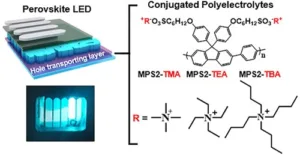A team of researchers led by Professors Myung-Hoon Song and Sang-Gyu Kwak of the Ulsan Institute of Science and Technology (Ulsan, Korea) in conjunction with Han-Young Woo of the Department of Chemistry at Korea University (Seoul, Korea) and others, recently announced the development of a perovskite-based LED (PeLED) technology that can enable improvements related to the emission of blue light.

First a few words of background information.
Perovskite is a crystal structure found in minerals. It was discovered in 1839 and named after Russian mineralogist Count Lev Alekseyevich von Perovski. A perovskite material is composed of organic molecules, metals and halogen elements and generally has a three dimensional lattice structure. Perovskites are a direct bandgap semiconductor and can strongly emit light. The color of the emitted light can be tuned quite easily, just by adjusting the size of the crystal. These properties make perovskites well suited for use in LEDs.
Additional factors that make perovskites well suited for use in LED applications that include color displays includes the facts that they are cheap and easy to fabricate. The reason for this is that perovskites can be processed in solution and do not need to be heated to a high temperature. A further positive related to the use of perovskites is that they can enable devices that have three times the efficiency when compared to similar devices based on conventional materials. In addition, the light emitted by perovskites has high color purity.
One negative aspect of the use of perovskites in light emitting applications is that blue PeLEDs consume a lot of power. The efficiency of converting electrical energy into blue light is only about 10%, a value less than half the efficiency of red and green PeLEDs. An additional problem is that the blue color purity is found to decrease over time. Due to low blue light efficiency and poor color stability, it has proven difficult to commercialize the use of perovskites as the light emitting material in display applications.
To address these issues, the researchers investigated a novel method to improve device performance. More specifically, they changed the material used in the hole transport layer, the layer of material in the device that is located adjacent to the perovskite layer. This approach was adopted rather than trying to manipulate the properties of the perovskite material itself.
A recent article on this topic by the team is entitled “Sky-Blue-Emissive Perovskite Light-Emitting Diodes: Crystal Growth and Interfacial Control Using Conjugated Polyelectrolytes as a Hole-Transporting Layer.” It was published in ACS Nano 2020, 14, 10, 13246-13255. A copy of the article is available for purchase and can be found here.
This article provides comprehensive information on the materials that were developed as well as details on the means used to evaluate test devices. The article is quite technical but here are a few of the main take-aways.
The team used a newly synthesized conjugated polymer electrolyte material as the hole transport layer in place of the conductive polymer used in conventional PeLED devices. When this new material was used as the hole transport layer, the regularity (crystallinity) of the perovskite three dimensional structure was improved and defects were reduced at the interface. As a consequence, the efficiency improved by 3 to 4 times compared to a conventional blue light emitting device. Furthermore, the emission is described as a clear blue color.
In addition, as the size of the side branch ions constituting the conjugated polymer electrolyte increased, the perovskite material had fewer defects at the interface. The figure below illustrates the device construction and the structure of conjugated polymer electrolyte molecules.
Upper left: A perovskite blue light emitting device. Lower left: An image showing the emission of blue light. Right: The structure of conjugated polymer electrolyte molecules.
A final feature of the new device structure is that the electroluminescence spectrum, an index indicating color purity, was demonstrated to have been “greatly stabilized.”
Based on these results, the team concludes their article by expressing the hope that their new approach will make it possible to accelerate the commercialization of perovskite-based display devices. -Arthur Berman
Ulsan Institute of Science and Technology, Myoung Hoon Song, [email protected], +82-52-217-2316

